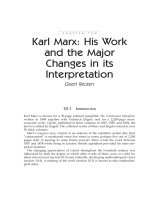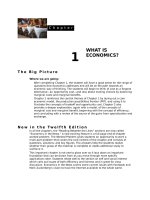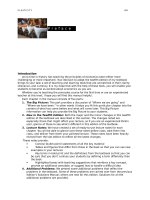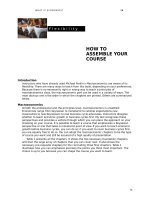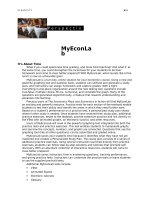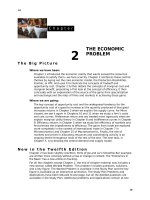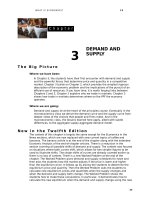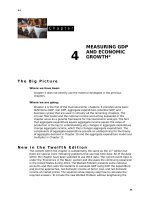Answers to review quizzes marcroeconomics 12e parkin chapter 10
Bạn đang xem bản rút gọn của tài liệu. Xem và tải ngay bản đầy đủ của tài liệu tại đây (747.74 KB, 17 trang )
W H AT I S E C O N O M I C S ?
171
1
0
AGGREGATE
SUPPLY AND
AGGREGATE
DEMAND**
Answers to the
Review Quizzes
Page 283 (page 691 in Economics)
1.
If the price level and the money wage rate rise by the same percentage, what
happens to the quantity of real GDP supplied? Along which aggregate supply
curve does the economy move?
If the price level and the money wage rate rise by the same percentage, there is no
change in the quantity of real GDP supplied and a movement occurs up along the
LAS curve.
2.
If the price level rises and the money wage rate remains constant, what
happens to the quantity of real GDP supplied? Along which aggregate supply
curve does the economy move?
If the price level rises and the money wage rate remains constant the quantity of
real GDP supplied increases and the economy moves along the SAS curve.
3.
If potential GDP increases, what happens to aggregate supply? Does the LAS
curve shift or is there a movement along the LAS curve? Does the SAS curve
shift or is there a movement along the SAS curve?
If potential GDP increases both long-run aggregate supply and short-run aggregate
supply increase and the LAS curve and SAS curve shift rightward.
4.
If the money wage rate rises and potential GDP remains the same, does the
LAS curve or the SAS curve shift or is there a movement along the LAS curve
or the SAS curve?
If the money wage rate rises and potential GDP remains the same there is a
decrease in short-run aggregate supply and no change in long-run aggregate
supply. The SAS curve shifts leftward and the LAS curve is unchanged.
Page 287 (page 695 in Economics)
1.
What does the aggregate demand curve show? What factors change and
what factors remain the same when there is a movement along the aggregate
demand curve?
171
172
The aggregate demand curve shows the relationship between the quantity of real
GDP demanded and the price level when other influences on expenditure plans
remain the same. When there is a movement along the aggregate demand curve,
the price level changes and other factors such as expectations, fiscal and
monetary policy, and the world economy remain the same.
2.
Why does the aggregate demand curve slope downward?
The aggregate demand curve slopes downward because of the wealth effect and
two substitution effects. First, a rise in the price level decreases real wealth, which
brings an increase in saving and a decrease in spending—the wealth effect.
Second, a rise in the price level raises the interest rate, which decreases borrowing
and spending—an intertemporal substitution effect as people decrease current
spending in favor of future spending—and increases the price of domestic goods
and services relative to foreign goods and services, which decreases exports and
increases imports—an international substitution effect.
3.
How do changes in expectations, fiscal policy and monetary policy, and the
world economy change aggregate demand and the aggregate demand
curve?
Aggregate demand increases and the AD curve shifts rightward if: expected future
income, expected future inflation, or expected future profits increase; government
expenditure increases or taxes are cut; the quantity of money increases and the
interest rate is cut; the exchange rate falls; or foreigners’ income increases. The
reverse changes decrease aggregate demand and shift the AD curve leftward.
Page 293 (page 701 in Economics)
1.
Does economic growth result from increases in aggregate demand, short-run
aggregate supply, or long-run aggregate supply?
Economic growth results from increases in long-run aggregate supply. Economic
growth occurs because the quantity of labor increases, capital is accumulated and
there are technological advances over time. All three of these factors increase
potential GDP and shift the LAS curve rightward.
2.
Does inflation result from increases in aggregate demand, short-run
aggregate supply, or long-run aggregate supply?
Inflation results from increases in aggregate demand that exceed the increase in
long-run aggregate supply. As the aggregate demand curve shifts rightward the
price level rises. Increases in AD that exceed increases in LAS produce inflation.
3.
Describe three types of short-run macroeconomic equilibrium.
Short-run macroeconomic equilibrium occurs when the quantity of real GDP
demanded equals the quantity of real GDP supplied. There are three types of shortrun equilibrium: below full-employment equilibrium where a recessionary gap
exists with real GDP less than potential GDP; above full-employment equilibrium
where an inflationary gap exists with real GDP greater than potential GDP; fullemployment equilibrium where no gap exists and real GDP equals potential GDP.
4.
How do fluctuations in aggregate demand and short-run aggregate supply
bring fluctuations in real GDP around potential GDP?
Fluctuations in aggregate demand with no change in short-run aggregate supply
bring fluctuations in real GDP around potential GDP. For instance, starting from full
employment, a decrease in aggregate demand decreases the price level and real
GDP and creates a recessionary gap. In the long run the money wage rate (and the
money prices of other resources) falls so that short-run aggregate supply increases
and the economy returns to its full employment equilibrium. Starting from full
employment, a decrease in short-run aggregate supply decreases real GDP and
172
W H AT I S E C O N O M I C S ?
173
raises the price level. The fall in real GDP combined with a rise in the price level is
a phenomenon called stagflation.
Page 295 (page 703 in Economics)
1.
What are the defining features of classical macroeconomics and what policies
do classical macroeconomists recommend?
Classical macroeconomists believe that the economy is self-regulating and always
at full employment. Classical macroeconomists assert that the proper government
policy is to minimize the disincentive effects of taxes on employment, investment,
and technological change.
2.
What are the defining features of Keynesian macroeconomics and what
policies do Keynesian macroeconomists recommend?
Keynesian macroeconomists believe that if the economy was left alone, it would
rarely operate at full employment. To achieve and maintain full employment the
economy needs active help from fiscal and monetary policy. Aggregate demand
fluctuations combined with a very sticky money wage rate are the major sources of
the business cycle. Keynesian macroeconomists assert that active fiscal and
monetary policy, designed to offset fluctuations in aggregate demand, are the
proper government policies.
3.
What are the defining features of monetarist macroeconomics and what
policies do monetarist macroeconomists recommend?
Monetarists believe that the economy is self-regulating and will typically operate at
full employment if monetary policy is not erratic and the money growth rate is kept
steady. The major source of business cycle fluctuations are similar to the
Keynesian view, that is, changes in aggregate demand combined with a sticky
money wage rate. However, according to monetarists, the changes in aggregate
demand are the result of fluctuations in the growth rate of money caused by the
Federal Reserve. Monetarists assert that the proper government policies are low
taxes, to avoid the disincentive effects stressed by classical macroeconomists, and
steady monetary growth.
173
Answers to the Study Plan Problems and
Applications
1.
Explain the influence of each of the following events on the quantity of real
GDP supplied and aggregate supply in India and use a graph to illustrate.
• U.S. firms move their call handling, IT, and data functions to India.
Moving call-handling, IT, and data
functions to India increases short-run
and long-run aggregate supply because
it increases the amount of employment
at full employment and (probably) also
increases the capital stock. As Figure
10.1 shows, both the short run aggregate
supply curve and long-run aggregate
supply curve shift rightward, from SAS 0
to SAS 1 and from LAS0 to LAS1.
•
Fuel prices rise.
The rise in fuel prices raises firms’ costs.
Short-run aggregate supply decreases
and the short-run aggregate supply
curve shifts leftward. Long-run aggregate
supply does not change. Figure 10.2
shows the leftward shift of the short-run
aggregate supply curve from SAS 0 to
SAS1.
•
Wal-Mart and Starbucks open in India.
When Starbucks and Wal-mart open in India, short-run and long-run aggregate
supply increase. When these stores open, employment at full employment
increases and India’s capital stock increases. Both the short-run and long-run
aggregate supply curves shift rightward, as illustrated in Figure 10.1.
•
Universities in India increase the number of engineering graduates.
Increasing the number of engineering graduates increases India’s human capital.
Both the short-run and long-run aggregate supply increases, as shown in Figure
A G G R E G A T E S U P P LY A N D A G G R E G AT E D E M A N D
10.1 by the rightward shifts in the short-run and long-run aggregate supply curves.
•
The money wage rate rises.
An increase in the money wage rate increases firms’ costs. Short-run aggregate
supply decreases but long-run aggregate supply does not change. Long-run
aggregate supply does not change because in the long run the price level rises by
the same percentage the money age rate increased, so in the long run
employment does not change. This situation is illustrated in Figure 10.2, in which
the short-run aggregate supply curve shifts leftward and the long-run aggregate
supply curve does not change.
•
The price level in India increases.
In the short run, an increase in the price
level increases the quantity of real GDP
supplied. In the long run, the money
wage rate rises by the same percentage
so in the long run there is no change in
the quantity of real GDP supplied. These
results are illustrated in Figure 10.3 by
the grey arrows showing the movement
along the short-run aggregate supply
curve, SAS, and the movement along the
long-run aggregate supply curve, LAS.
2.
Labor productivity is rising at a rapid rate in China and wages are rising at a
similar rate. Explain how a rise in labor productivity and wages in China will
influence the quantity of real GDP supplied and aggregate supply in China.
The rise in labor productivity increases potential GDP and increases aggregate
supply. The short-run and long-run aggregate supply curves shift rightward. The
rise in the money wage rate in China decreases short-run aggregate supply and
shifts the short-run aggregate supply curve leftward. It has no effect on potential
GDP or on the long-run aggregate supply curve.
3.
Canada trades with the United States. Explain the effect of each of the
following events on Canada’s aggregate demand.
• The government of Canada cuts income taxes.
Cutting income taxes increases aggregate demand because it increases people’s
disposable incomes.
•
The United States experiences strong economic growth.
Strong growth in the United States increases U.S. demand for Canadian exports.
Canadian exports are a component of Canada’s aggregate demand so the increase
in demand for Canada’s exports means that Canada’s aggregate demand
increases.
127
128
•
CHAPTER 10
Canada sets new environmental standards that require power utilities to
upgrade their production facilities.
To upgrade their facilities, power utilities must increase their investment.
Investment is a component of aggregate demand so an increase in investment
means that Canada’s aggregate demand increases.
4.
The Fed cuts the quantity of money and all other things remain the same.
Explain the effect of the cut in the quantity of money on aggregate demand
in the short run.
A decrease in the quantity of money decreases aggregate demand and shifts the
AD curve leftward. By cutting the quantity of money, the interest rate rises, so
firms decrease their investment and households cut back their expenditure on new
homes, new cars, and other big-ticket items. The decrease in consumption
expenditure and investment both decrease aggregate demand.
5.
Gross Domestic Product for the Second Quarter of 2012
The increase in real GDP in the second quarter primarily reflected increases in
personal consumption expenditures, exports, and investment. Government
spending decreased.
Source: Bureau of Economic Analysis, August 29, 2012
Explain how the items in the news clip influence U.S. aggregate demand.
The increase in consumption expenditures, exports, and investment all increase
U.S. aggregate demand. The decrease in government spending decreases U.S.
aggregate demand.
Use Figure 10.4 to work Problems 6 to 8.
Initially, the short-run aggregate supply
curve is SAS0 and the aggregate demand
curve is AD0.
6.
Some events change aggregate
demand from AD0 to AD1. Describe two
events that could have created this
change in aggregate demand. What is
the equilibrium after aggregate
demand changed? If potential GDP is
$1 trillion, the economy is at what the
type of macroeconomic equilibrium?
Aggregate demand increases when the
aggregate demand curve shifts from
AD0 to AD1. Aggregate demand
increases if expected future income,
expected future inflation, or expected
future profit increases; if the government cuts taxes, increases its expenditure on
goods and services, or increases its transfer payments; if the Fed lowers the
interest rate; or if the U.S. exchange rate falls or foreign income increases. After
the change in aggregate demand, equilibrium is at point C: real GDP is $1.1 trillion
and the price level is 105. The economy is at an above full-employment
equilibrium with an inflationary gap.
A G G R E G A T E S U P P LY A N D A G G R E G AT E D E M A N D
7.
Some events change aggregate supply from SAS0 to SAS1. Describe two
events that could have created this change in aggregate supply. What is the
equilibrium after aggregate supply changed? If potential GDP is $1 trillion,
does the economy have an inflationary gap, a recessionary gap, or no output
gap?
Aggregate supply decreases when the aggregate supply curve shifts from SAS 0 to
SAS 1. Aggregate supply decreases if potential GDP decreases; if the money wage
rate rises; or if the money prices of other resources rise. After the change,
equilibrium is at point A: real GDP is $0.9 trillion and the price level is 105. The
economy is at a below full-employment equilibrium with a recessionary gap.
8.
Some events change aggregate demand from AD0 to AD1 and aggregate
supply from SAS0 to SAS1. What is the new macroeconomic equilibrium?
After the changes, equilibrium is at point D: real GDP is $1.0 trillion and the price
level is 110. The economy is at a full-employment equilibrium.
9.
Describe the policy change that a classical macroeconomist, a Keynesian, and
a monetarist would recommend for U.S. policymakers to adopt in response to
each of the following events:
a. Growth in the world economy slows.
Classical economists probably would recommend no policy action. If they
suggested any policy at all, the policy would involve cutting taxes. Monetarist
economists would recommend an increase in the quantity of money, which lowers
the interest rate. Keynesian economists likely would suggest several policies, such
as the U.S. government should increase aggregate demand by increasing its
expenditure on goods and services or by cutting taxes. Keynesian economists also
would suggest that the Fed should increase the quantity of money and lower
interest rates.
b. The world price of oil rises.
Classical and monetarist economists probably would recommend no policy action.
If they suggested any policy at all, the policy would involve cutting taxes.
Keynesian economists likely would suggest several policies, such as the U.S.
government should increase aggregate demand by increasing its expenditure on
goods and services or by cutting taxes. Keynesian economists also would suggest
that the Fed should increase the quantity of money and lower interest rates.
c. U.S. labor productivity declines.
Classical economists probably would recommend no policy action. If they
suggested any policy at all, the policy would involve cutting taxes. Monetarist
economists would recommend an increase in the quantity of money, which lowers
the interest rate. Keynesian economists likely would suggest several policies, such
as the U.S. government should increase aggregate demand by increasing its
expenditure on goods and services or by cutting taxes. Keynesian economists also
would suggest that the Fed should increase the quantity of money and lower
interest rates.
129
130
CHAPTER 10
Answers to Additional Problems and Applications
10.
Explain for each event whether it changes the quantity of real GDP supplied,
short-run aggregate supply, long-run aggregate supply, or a combination of
them.
• Hong Kong firms switch to lower-cost 3D printing technology.
New technology raises productivity, which increases both short-run and long-run
aggregate supply.
•
An ageing population is expected to shrink Hong Kong’s labor force.
Shrinking labor force decreases short-run and long-run aggregate supply.
•
Foreign students in Hong Kong universities get temporary work permits.
•
Firms from mainland China open offices in Hong Kong.
Increase in labor force increases short-run and long-run aggregate supply.
•
An increase in the quantity of capital increases short-run and long-run aggregate
supply.
The Hong Kong price level rises.
A rise in the price level might result from an increase in aggregate demand, which
causes an increase in the quantity of real GDP supplied, or from a decrease in
short-run aggregate supply, which causes a decrease in the quantity of real GDP
demanded.
11.
Examine for each event whether it changes the quantity of real GDP
demanded or aggregate demand in Japan.
• Japanese price level rises.
•
A rise in the Japanese price level leads to a decrease in the quantity of real GDP
demanded.
Depreciation of yen attracts more tourists to Japan.
Exports of services increase which increases aggregate demand.
•
Japan’s coal consumption rises due to a prolonged shut down of nuclear
plants.
The increase in consumption expenditure increases aggregate demand.
•
Japan’s sales tax rises.
Higher sales tax lowers consumption expenditure, which decreases aggregate
demand.
12.
Changes in Inventory Investment
When real GDP increased in the first quarter of 2015, personal consumption
expenditure, private inventory investment, and imports increased while
exports, nonresidential fixed investment, and government spending
decreased.
Source: Bureau of Economic Analysis, April 29, 2015
Explain how the increase in private inventory investment affected U.S.
aggregate demand.
Private inventory investment is the change in value of firms’ stocks of unfinished
or finished but unsold goods. It is a type of investment expenditure. The increase in
inventory investment increased aggregate demand.
A G G R E G A T E S U P P LY A N D A G G R E G AT E D E M A N D
13.
Exports and Imports Increase
Real exports of goods and services increased 6.0 percent in the second
quarter, compared with an increase of 4.4 percent in the first. Real imports of
goods and services increased 2.9 percent, compared with an increase of 3.1
percent.
Source: Bureau of Economic Analysis, August 29, 2012
Explain how the changes in exports and imports reported here influence the
quantity of real GDP demanded and aggregate demand. In which of the two
quarters reported did exports and imports make the greater contribution to
aggregate demand growth?
Net exports is part of aggregate demand, which means that an increase in net
exports increases aggregate demand. Net exports equals exports minus imports,
so an increase in exports increases aggregate demand while an increase in
imports decreases aggregate demand. In both quarters, exports increased so in
both quarters exports increased aggregate demand. In both quarters, imports
increased, so in both quarters imports decreased aggregate demand. The biggest
contribution to economic growth was in the second quarter, because export growth
rose significantly from 4.4 percent to 6.0 percent while import growth fell, from 3.1
percent to 2.9 percent.
Use the following information to work Problems 14 to 16.
According to the East Asia and Pacific Economic Update published by the World
Bank in April 2015, the following factors have affected China’s real GDP in
2015.
• Global economic recovery supports a moderate increase in China’s exports.
• China benefits from a fall in the world price of oil.
• Chinese government to cut excess capacity in heavy industry.
•
U.S. firms to relocate their labor-intensive manufacturing industries to lowcost countries.
14.
Explain how each of the above factors changes short-run aggregate supply,
long-run aggregate supply, aggregate demand, or some combination of them.
The global economic recovery increases China’s exports, which increases
aggregate demand. As the world price of oil is prone to fluctuations in the long run,
a fall in the world price of oil leads to an increase in short-run aggregate supply.
The cut back in the excess capacity of production in heavy industry does not
change short-run aggregate supply and long-run aggregate supply. As the excess
capacity is reduced, the expected returns to new investment (in capacity) increase,
leading to an increase in aggregate demand. The relocation of labor-intensive
manufacturing industries from the U.S. to low-cost countries such as China
increases production, increasing both the short-run aggregate supply and the longrun aggregate supply.
15.
Explain how each factor separately affect China’s real GDP and the price
level, starting from a position of long-run equilibrium.
The increase in China’s exports raises the price level and increases real GDP. The
fall in the world price of oil increases short-run aggregate supply, which decreases
the price level and real GDP. The reduction in excess capacity of production in
heavy industry does not change short-run aggregate supply and long-run
aggregate supply. Due to an increase in expected returns from new investment,
aggregate demand increases, which raises the price level and increases real GDP.
The relocation of labor-intensive manufacturing industries to China increases
131
132
CHAPTER 10
short-run aggregate supply and long-run aggregate supply, which decreases the
price level and increases real GDP.
16.
Explain the combined effects of these factors on China’s real GDP and the
price level, starting from a position of long-run equilibrium.
The combined effect is that real GDP increases but the effect on the price level is
uncertain. All factors (except global economic recovery which increases China’s
exports) lower the price level. The increase in China’s exports raises the price
level.
A G G R E G A T E S U P P LY A N D A G G R E G AT E D E M A N D
Use the following information to work Problems 17 and 18.
In Japan, potential GDP is 600 trillion
Real GDP
Real GDP supplied
yen. The table shows the aggregate
demanded
in the short run
demand and short-run aggregate
Price
(trillions of 2005 yen)
supply schedules.
level
17.a. Draw a graph of the
75
600
400
aggregate demand curve and
85
550
450
the short-run aggregate
95
500
500
supply curve.
105
450
550
Figure 10.5 shows the
115
400
600
aggregate demand curve and
125
350
650
the short-run aggregate supply
135
300
700
curve.
b. What is the short-run
equilibrium real GDP and price level?
Equilibrium real GDP is ¥500 trillion and the price level is 95. Short-run
macroeconomic equilibrium occurs at
the intersection of the aggregate
demand curve and the short-run
aggregate supply curve.
18.
Does Japan have an inflationary gap
or a recessionary gap and what is its
magnitude?
Equilibrium real GDP is less than
potential GDP, so Japan has a
recessionary gap. The recessionary
gap equals the difference between
potential GDP and real GDP, which is
¥100 trillion.
Use the following information to work Problems 19 and 20.
Spending by Women Jumps
The magazine Women of China reported that Chinese women in big cities spent
63% of their income on consumer goods last year, up from 26% in 2007. Clothing
accounted for the biggest chunk of that spending, at nearly 30%, followed by
digital products such as cellphones (11%) and travel (10%). Chinese consumption
as a whole grew faster than the overall economy and is expected to reach 42% of
GDP by 2020, up from the current 36%.
Source: The Wall Street Journal, August 27, 2010
19. Explain the effect of a rise in consumption expenditure on real GDP and the
price level in the short run.
Figure 10.6 (on the next page) shows the effect from the increase in consumption
expenditure. Consumption expenditure is one of the components of aggregate
demand, so an increase in consumption expenditure increases aggregate demand
133
134
CHAPTER 10
and shifts the aggregate demand curve
rightward. In the figure the aggregate
demand curve shifts from AD0 to AD1.
Because aggregate demand increased,
equilibrium real GDP increases (in
Figure 10.6 from 33.0 trillion yuan to
33.2 trillion yuan) and the price level
rises (in the figure from 117 to 119).
20.
If the economy had been operating at
a full-employment equilibrium,
a. Describe the macroeconomic
equilibrium after the rise in consumer
spending.
If the economy had been operating at a
full-employment equilibrium before the
increase in consumer expenditure, after
the increase equilibrium real GDP
exceeds potential GDP. The economy is
at an above full-employment equilibrium with an inflationary gap.
b. Explain and draw a graph to illustrate how the economy can adjust in the
long run to restore a full-employment equilibrium.
Figure 10.7 shows how the economy can adjust to its long-run equilibrium. In the
short run, real GDP exceeds potential GDP. Employment exceeds full employment.
The tight labor market means that the
money wage rate starts to rise. As the
money wage rate rises short-run
aggregate supply decreases and the
short-run aggregate supply curve shifts
leftward. Real GDP and employment
decrease. Even though employment is
decreasing, as long as employment
exceeds full employment, the money
wage rate continues to rise and the
short-run aggregate supply continues to
decrease. The process ultimately ends
when real GDP has decreased back to
equal potential GDP and employment
equals full employment. Short-run
aggregate supply has decreased and
the short-run aggregate supply curve
has shifted from SAS 0 to SAS1. At this
point the price level has risen (to 121 in
Figure 10.7) and real GDP has returned to potential GDP (33.0 trillion yuan).
21.
Suppose that the E.U. economy goes into an expansion. Explain the effect of
the expansion on U.S. real GDP and unemployment in the short run.
When the E.U. economy moves into an expansion, U.S. exports to the E.U. increase.
The increase in U.S. exports increases U.S. aggregate demand, thereby increasing
U.S. real GDP and lowering U.S. unemployment.
A G G R E G A T E S U P P LY A N D A G G R E G AT E D E M A N D
22.
Explain why changes in consumer spending and business investment play a
large role in the business cycle.
Changes in consumer spending play a large role in business cycles because
consumption expenditure is by far the largest part of GDP. A small percentage
change in consumption expenditure is a large change in aggregate demand which
can lead to a large change in real GDP.
Changes in investment spending are also important because investment spending
is quite volatile and subject to large changes. Consequently a decrease in
investment often leads to a large decrease in aggregate demand and a recession
while an increase frequently results in a large increase in aggregate demand and
an expansion.
23.
How to Avoid Recession? Let the Fed Do Its Work
Greg Mankiw wrote in 2007 on the eve of the Global Financial Crisis,
“Congress made its most important contribution to taming the business cycle
back in 1913, when it created the Federal Reserve System. Today, the Fed
remains the first line of defense against recession.”
Source: The New York Times, December 23, 2007
a. Describe the process by which action by the Fed in times of recession flows
through the economy.
An increase in the quantity of money lowers interest rates and makes it easier to
get a loan. The lower interest rate leads businesses to increase their investment
and households to increase spending on new homes and other consumer durables.
Banks, eager to lend, lower their lending standards and more people and firms
qualify for loans. All these effects increase aggregate demand and thereby raise
real GDP.
b. Draw a graph to illustrate the Fed’s action and its effect.
Figure 10.8 shows how the Fed’s
action increases aggregate demand,
shifting the aggregate demand curve
rightward from AD0 to AD1. Real GDP
increases from $16.0 trillion to $16.2
trillion.
24.
Cut Taxes and Boost Spending?
Raise Taxes and Cut Spending?
Cut Taxes and Cut Spending
This headline expresses three views
about what to do to get the U.S.
economy growing more rapidly and
contribute to closing a large
recessionary gap. Economists from
which macroeconomic school of
thought would recommend pursuing
policies described by each of these
views?
The first policy, cut taxes and boost spending, would be endorsed by the Keynesian
and new Keynesian schools. The second policy, raise taxes and cut spending, is
endorsed by no school of thought. The third policy, cut taxes and cut spending,
would be endorsed by the classical and new classical schools.
135
136
CHAPTER 10
Economics in the News
25.
After you have studied Economics in the News on pp. 296–297 (704–705 in
Economics), answer the following questions.
a. What are the main features of the U.S. economy in the second quarter of
2014?
The main feature of the U.S. economy in the second quarter of 2014 was rapid
growth. The economy grew at a faster than average rate of 4.2 percent in that
quarter. The growth rate was significantly more rapid than in the first quarter
when the U.S. economy grew at only 2.1 percent.
b. Did the United States have a recessionary gap or an inflationary gap in
2014? How do you know?
The U.S. economy had a recessionary gap. Unemployment was high and actual
GDP was below potential GDP.
c. Use the AS-AD model to show the changes in aggregate demand and
aggregate supply that occurred in 2013 and 2014 that brought the economy
to its situation in mid-2014.
Figure 10.9 shows the
changes between 2013 and
2014. There was a
recessionary gap so in the
figure the aggregate
demand curve, AD13, and
the short-run aggregate
supply curve, SAS 13,
intersect to the left of the
long-run aggregate supply
curve, LAS13. Potential GDP
was $16.5 trillion in 2013
and actual real GDP was
only $15.6 trillion. The
economy had a large
recessionary gap though it
would shrink in 2014. In
2013 and 2014 fiscal and
monetary policy as well as
an expanding world economy increased aggregate demand. Short-run aggregate
supply did not change because the increase in potential GDP (which increases
short-run aggregate supply) was small and probably offset by a higher money
wage rate (which decreases
short-run aggregate supply).
The aggregate demand
curve shifted rightward, to
AD14 in Figure 10.9. The
economy remained below
full employment because the
long-run aggregate supply
curve had shifted rightward
to LAS14. Real GDP was
$16.0 trillion but potential
GDP was $16.7 trillion.
A G G R E G A T E S U P P LY A N D A G G R E G AT E D E M A N D
d. Use the AS-AD model to show the changes in aggregate demand and
aggregate supply that will have occurred when full employment is restored.
Figure 10.10 shows this result. In it the aggregate demand curve has shifted
rightward from AD14 to ADpolicy. Equilibrium real GDP is $16.7 trillion, the same as
potential GDP. The price level has risen, from 108 to a little less than 112.
137
138
CHAPTER 10
e. Use the AS-AD model to show the changes in aggregate demand and
aggregate supply that would occur if the federal government increased its
expenditure on goods and services or cut taxes by enough to restore full
employment.
Fiscal policy of increasing government expenditure on goods and services or
cutting taxes increases aggregate demand and shifts the aggregate demand curve
rightward. Figure 10.10 shows this policy. In it the aggregate demand curve has
shifted rightward from AD14 to ADpolicy. Equilibrium real GDP is $16.7 trillion, the
same as potential GDP. The price level has risen, from 108 to 112.
f.
Use the AS-AD model to show the changes in aggregate demand and
aggregate supply that would occur if the economy moved into an
inflationary gap. Show the
short-run and the long-run
effects.
If government policy leads to
an inflationary gap, the
aggregate demand curve
will have shifted rightward
so that it intersects the
short-run aggregate supply
curve at a point to the right
of potential GDP. In Figure
10.11, the government
policy would shift the
aggregate demand curve to
AD. The price level is 112.5
and equilibrium real GDP is
$16.9 trillion while potential
GDP is only $16.7 trillion.
The economy has an
inflationary gap. In the long run, the inflationary gap will be eliminated. For
simplicity, presuming that neither potential GDP nor aggregate demand increase,
the tight labor market will lead to increases in the money wage rate. As the money
wage rate rises, firms’ costs increase. The short-run aggregate supply decreases
and the short-run aggregate supply curve shifts leftward. Eventually aggregate
supply decreases so that the short-run aggregate supply curve has shifted to SAS
in Figure 10.11. At that moment, the economy is back to full employment:
Equilibrium real GDP, $16.7 trillion, equals potential GDP, also $16.7 trillion. The
price level, of course, has risen, in the figure from 112.5 to 114.0.
26.
Brazil Falls into Recession
A decade ago, Brazil had rapid growth but now its economy is experiencing a
slowdown with investment falling, and inventories increasing. Potential GDP
growth rate has slowed. Business and consumer confidence has fallen.
Source: BBC News, August 29, 2014
a. Explain the effect of a decrease in investment on real GDP and potential
GDP.
The first effect of a decrease in investment is a decrease in aggregate demand.
The decrease in aggregate demand decreases real GDP. As investment remains
depressed, the capital stock grows more slowly, which decreases the growth rate
of potential GDP.
A G G R E G A T E S U P P LY A N D A G G R E G AT E D E M A N D
b. Explain how business and consumer confidence influences aggregate
expenditure.
The decrease in business confidence leads businesses to decrease their
investment. The decrease in investment decreases the Brazil’s aggregate
expenditure. Similarly, the decrease in consumer confidence lowers consumer
expenditure, thereby again decreasing Brazil’s aggregate expenditure.
139
